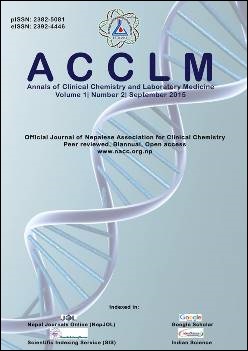Study of Viral Diarrhoea and Associated Risk Factors Among Under Five Years Old Children in Dhulikhel Hospital, Kathmandu University Hospital
DOI:
https://doi.org/10.3126/acclm.v1i2.13095Keywords:
Children, diarrhoea, dehydration, rotavirusAbstract
BACKGROUND: Diarrhoea is a major health problem among children. It remains a major cause of childhood morbidity and mortality worldwide, with particularly high morbidity in children younger than 5 years of age. The objective of this study is to determine the frequency and associated risk factors of viral diarrhoea in children less than 5 years of age at Dhulikhel Hospital, Kathmandu University Hospital, Nepal and also to study the clinical presentation and the common causes of acute childhood diarrhoea.
METHODS: This is a hospital based, prospective, non-interventional study conducted in Dhulikhel hospital. A total of 100 cases attending Dhulikhel hospital between 1st December 2011 to 31st March 2012, presented with acute onset of diarrhoea were enrolled in the study. During the study period the parents were asked to respond to questionnaires regarding their family size, educational status and knowledge of Oral Rehydration Solution (ORS), their water source and sanitation, personal hygiene and food habit. The children were examined, assessed for dehydration and anthropometry was also taken. The fresh stool specimens were analysed in the hospital laboratory in order to look for the common pathogens. All the statistical analysis was done using both descriptive and inferential (chi-squared test) statistics with the help of SPSS 20 software.
RESULTS: Out of 100 children studied 69% were males and 31% females. Majority of the study population were below 24 months of age (77%). Majority were classified as no dehydration (75%) as per WHO guidelines for assessment of dehydration. The main source of drinking water in the family was tap water (65%), 44% didn’t used any method for water purification and 26% had no habits of hand washing in the family, 89% of the mothers had a good knowledge of ORS. Majority had no history of fever (64%). 37% of cases needed hospital admission among which 7 cases needed PICU care. Test was positive for Rotavirus in significant number of cases (66%) followed by Adenovirus (13%).
CONCLUSIONS: Incidence of Acute diarrhoea is highest below 24 months of age. As the age increases the incidence decreases. Lack of safe drinking water, poor sanitation and poor living conditions are associated risk factors for childhood diarrhoea. Viral diarrhoea is still the most common cause of childhood diarrhoea. Most children are not dehydrated and can be managed using ORS at home or in primary health care centres. We expect that results of the study would be useful initiation of vaccine requirements in a developing country like Nepal.
Downloads
1365
821
Downloads
Published
How to Cite
Issue
Section
License
Authors who publish with this journal agree to the following terms:
- The author transfers copyright to the Nepalese Association for Clinical Chemistry.
- The journal publishes the work under a Creative Commons Attribution License that allows others to share the work with an acknowledgement of the work's authorship and initial publication in this journal and under the same share-alike license used here.
- Authors are able to enter into separate, additional contractual arrangements for the non-exclusive distribution of the journal's published version of the work (e.g., post it to an institutional repository or publish it in a book), with an acknowledgement of its initial publication in this journal.
- Authors are permitted and encouraged to post their work online (e.g., in institutional repositories or on their website) prior to and during the submission process, as it can lead to productive exchanges, as well as earlier and greater citation of published work (See The Effect of Open Access).




